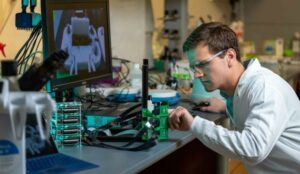Several orbiting space telescopes scanning the skies for powerful cosmic explosions have spotted one of the brightest gamma-ray bursts ever detected. Initial evidence suggests that the blast of high-energy radiation occurred when an extremely massive star collapsed – a process that results in an immense flood of gamma-rays and X-rays. Astronomers have been racing to follow-up the discovery with one researcher suggesting it will become the “best studied gamma-ray burst in history”.
The first reports of the explosion, catalogued as GRB 221009A, came from the Neil Gehrels Swift observatory and the Fermi Gamma-ray Space Telescope, which both monitor the universe at gamma-ray and X-ray wavelengths. Their systems noticed a bright source appear in the constellation Sagitta on 9 October. The blast was also picked up by the European Space Agency’s Solar Orbiter mission and since then numerous other observatories – including those looking at visible wavelengths – have scrutinized the fading fireball from the event, which is known as the “afterglow”.
One of the most striking aspects about GRB 221009A is its proximity. The blast appears to have happened in a galaxy about two billion light years away, which is considerably closer than an “average” gamma-ray burst event that may lie some 10 billion light years away. Leicester University astronomer Kim Page, who works on NASA’s Swift mission, says that such closeness had “a big part to play” in why this burst appeared so bright.
The bright and nearby nature of GRB 221009A should give scientists plenty to study. “We have a lot photons across the electromagnetic spectrum, and this will allow us to slice up the data more finely,” adds Page. Researchers will also be hoping to examine how the chemical signature, or spectrum, of the explosion evolves – information that can reveal clues about the composition of the phenomenon.
A ‘unique’ measurement
While initial analyses are still ongoing, astronomers are already marvelling at some of the early observations. X-ray imagery from the Swift observatory shows prominent, glowing rings around the location of GRB 221009A. These features are not physically part of the blast but “light echoes” that are caused when X-ray radiation streaming towards us from the event scatters off microscopic grains suspended within dust clouds inside our own galaxy.
GRB 221009A is going to be the best studied gamma-ray burst in history
Andrea Tiengo
“This is by far the best set of rings seen around a gamma-ray burst, thanks partly to its brightness in X-rays and its closeness to the Galactic plane,” explains Leicester astronomer Andrew Beardmore, who works on the Swift mission.
Beardmore says analysis of the rings will allow scientists to investigate the nature of the interstellar dust grains and even probe the locations of the Milky Way dust clouds where they reside. “Because [the rings] are so bright, the distance to the dust-layers responsible for [them] will likely be known with great precision. This makes it quite a unique measurement,” he adds.

Why are gamma-ray bursts so extremely interesting?
Indeed, that measurement is something that Andrea Tiengo from the Scuola Universitaria Superiore IUSS di Pavia, in Italy, and colleagues have already been working on. “We have compared our measurements with the distances derived from other methods and we confirm that they are compatible,” he says. “But we detect more clouds up to a larger distance and determine their distance with higher accuracy.”
The dust responsible for the rings has also scattered a particular kind of X-ray light from the early stages of the blast. These so-called “soft” X-rays – with energies of between 0.3 and 10 keV – aren’t usually emitted towards us during these events, but they can be studied for details about the star that formed the gamma-ray burst.
“Since GRB 221009A is going to be the best studied gamma-ray burst in history, this is a fundamental piece of information that would otherwise be missing and it will certainly help us to better understand the physics of the most powerful explosions in the universe,” says Tiengo.













